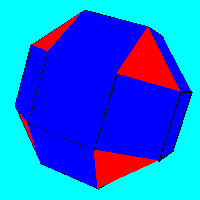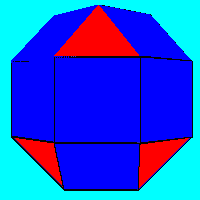Copyright © University of Cambridge. All rights reserved.
'Rhombicubocts' printed from https://nrich.maths.org/
Show menu
 |
 |
| Rhombicuboctahedron | Pseudo-rhombicuboctahedron |
Each of these solids is made up with 3 squares and a triangle around each vertex. Each has a total of 18 square faces and 8 faces that are equilateral triangles. Each has a band of 8 squares around the 'equator' and two square faces at the top and bottom (parallel to the equator) containing the 'north and south poles' at their centres. Draw the net for making each of the shapes and make the models for yourself either with card or a plastic constriction kit. How many faces, edges and vertices does each solid have? How many planes of symmetry and how many axes of rotational symmetry?
The solid on the left is one of the classical semi-regular or Archimedean solids but the one on the right was almost entirely ignored until it was made known by JCP Miller in the 1930s. Perhaps people thought the two were the same - can you describe the differences?